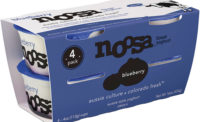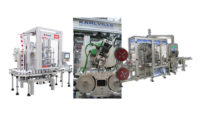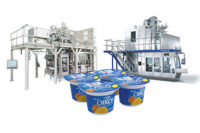The flexible packaging segment is proving its staying power as sales are up and more and more food and beverage products roll out onto store shelves in this format. According to Frost & Sullivan, flexible packaging sales reached 25.4 billion in 2011 and the firm estimates that in 2016 this number will look more like 30.63 billion. Why the growth? Read on for expert insights and a look at the emerging pouches forming this segment.
I reached out to Dennis Calamusa, president and founder of Allied Flex Technology, a sales, marketing & consulting Group that provides global flexible packaging machinery systems and technologies to the North & South American markets. I also had to chance to correspond with Greg Bunker, group marketing director, food and specialty packaging at the Dow Chemical Company. They both weighed in on the flexible packaging industry, where it’s been, where it’s going and why the blossoming popularity.
FBP: Why in your opinion are food/beverage companies moving to flexible packaging?
Dennis Calamusa: I believe food and beverage companies are beginning to explore shifting to flexible alternatives due to growing consumer acceptance. Consumers appreciate the convenience and portability of a pouch, as opposed to a traditional bottle, jar or can. Offering consumers a flexible packaging alternative does not need to mean you are replacing your rigid packaging. Food and beverage companies are starting to recognize that the pouch or flexible format can better address the changing needs of the consumer, creating new marketing opportunities, in addition to opportunities to reduce cost. This is the reason that value added line extensions have been such a successful way to start their transition strategy, by partnering their existing packaging methods with flexible packaging alternatives, and along the way they sell more of their product and increase market share.
Greg Bunker: Flexible packaging is the most cost-efficient form of food packaging. It can be designed to provide the best balance of barrier, durability and branding versus most other materials and formats. One of the main reasons for this is that film fabrication technology has developed over the years. This allows the incorporation of the best choice of materials in separate layers in the package to provide the optimum cost-performance balance for the product being packaged.
The combination of advances in film fabrication and pouch-forming equipment are driving stand-up pouch production by making the economics more attractive for both new and replacement products.
FBP: How does flexible packaging benefit consumer packaged goods companies (CPGs) in terms of sustainability?
Calamusa: Today more and more CPG’s are really starting to do their homework and are becoming more aware of the negative environmental impact of many rigid package formats from a cradle to grave perspective. Logistics, including transportation, package weight and warehousing of rigid packaging all have a huge impact on total cost, packaging process complexity, as well as environmental impact. It’s not just all about recycling as flexible packaging continues to evolve and increase, creative re-use programs will continue to evolve to better address the management of disposal and waste concerns.
Bunker: First, less material, and therefore less energy, is used to create flexible plastic packages. This reduced weight also means it is more energy efficient to transport both unfilled and filled packages. Second, many plastic packages can be recycled. They can be used to make other products or converted into energy at a waste to energy plant. Also, about 30 percent of the world’s food is wasted, due to spoilage. Flexible plastic packaging is built with layers that serve a variety of functions in keeping contaminants out while helping preserve the food’s aroma, taste and texture.
FBP: What are the challenges that packagers face when moving their product line from rigid to flexible?
Calamusa: The “challenges of change” is always a consideration when moving from old to new. This is the reason we encourage our clients to consider transitioning their packaging gradually and not plan total replacement of their traditional packaging in the short run; this is particularly the case when substantial infrastructure is in place. The challenges of change will impact capital investment, distribution, retail marketing, etc. In addition the philosophy of how things were done over decades will also need to shift to a new operating philosophy. The good news is that many companies are realizing that it’s worth the time, effort and investment.
Bunker: They must consider how consumers will accept the change from current packaging to something new, as well as how the new packaging will change consumers’ experience of the product. There are many advantages for brand owners, often including reduced material and shipping costs, but flexible packaging can also enhance the consumers’ experience. Once the consumer trade-offs have been considered, the actual packaging costs need to be considered.
Sprouting pouches
The benefits of flexible packaging include the convenience of the package, its unbreakable quality and its portability, both in the shipping scenario and a consumer perk. The format also keeps food and beverages fresh, protects the contents inside and can usually be recycled. But also, in comparison to rigid containers, flexible packaging uses less resources and produces a thinner, lighter overall package.
That being said, a few sprouting pouches are surprising (albeit pleasantly) to see as traditional products emerge in new flexible packaging formats.
“I am constantly surprised at the creativity of our customers, particularly when we see very mature product categories switch from traditional packaging to innovative flexible packaging. We are typically taught not to shift to something new due to the potential risks, however we have seen complete product categories be reinvented by the introduction of new and different packaging. This flexible packaging phenomenon is occurring across a multitude of markets and product categories,” Calamusa says.
One particular product that I was initially surprised to see move to flexible packaging is wine. Traditionally wine has been packed in either glass or made more recently popular, PET. Now, there are several options for wine in flexible packaging like pouches and cartons.
Oneglass wine, from Verona Italy, packages its wine in 100ml, foil-lined pouches that are made mostly from paper (75%), polyethylene (20%) and aluminum (5%) that can be entirely recycled. Oneglass wines are packaged in a rollstock pouch and made with paperboard lamination that gives it a more carton-like appearance and form but with the proper barrier properties to keep the product fresh and extend its shelf life.
CalNaturale wines are available in two sizes, 500ml and 1-liter cartons from Tetra-Pak. CalNaturale wine is convenient and environmentally friendly, utilizing less than half the greenhouse gases, waste and energy in production and transportation.
Instead of individual-serving wine pouches, the AstraPouch offers pouched wine for a crowd. Impaq (www.astrapouch-na.com) is the exclusive supplier of the AstraPouch in the US and Canada. The pouch is made from a multi-layer lamination of food grade polyethylene and PET and is complete with handles and dispensing tap for easy consumer use. The pouch concept was created by a South African flexible package producer as an innovative wine and spirits packaging format. Manufactured in the U.S., the pouch offers a convenient wine and spirits package.
Another interesting example of packages moving from rigid to flexible is baby food. Pouches of baby food are everywhere from brands like Plum, Happy Baby and even private label brands like Target’s up & up. The pouches offer moms an easy way to bring the food on the go.
One company is taking pouched baby food to a new level, offering mom the chance to not only easily transport the food, but also the ability to package homemade baby food in a convenient pouch. The U-Fill Snack Pack ™ Fitment Pouches, from Rowan U-Fill Group, are designed for homemade baby food and come equipped with a spout.
Flair Flexible Packaging worked closely with Rowan U-Fill Group to create the pouch that is freezable, food safe and BPA-free. The 4-ounce multilayer laminate pouches come complete with write-on labels for noting dates and contents. The multilayer laminate structure limits both light and moisture transmission to keep food fresh longer.
Flexible packaging helps brands add to their existing line-up with a consumer-driven (and well-received) package that touts convenience and portability.







